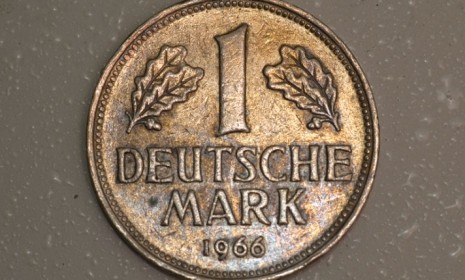Why are Germans still using the deutsche mark?
Officially, Europe's economic powerhouse uses the euro. But there are still billions upon billions of deutsche marks being traded all around Germany

With the eurozone debt crisis still raging, Europeans could be forgiven for pining for the days when nations had their own currencies. But many Germans are taking their love of the deutsche mark to a whole new level, says Vanessa Fuhrmans at The Wall Street Journal, "indulging their nostalgia for the abandoned mark by shopping with it again — and retailers are happily going along." Indeed, "the 'die gute alte D-mark,' or 'the good old D-mark,' as it is still affectionately called, is far from dead." Here, a guide to the currency's renewed popularity:
Wait. Isn't the deutsche mark defunct?
Yes. Germany officially switched to the euro on Jan. 1, 2002, and the deutsche mark "immediately ceased to be legal tender," says Furhmans. However, unlike other countries that use the euro, Germany never set a deadline by which people had to trade their marks for euros. Individuals and businesses can still exchange their marks at government banks, at a rate of 1.96 marks per euro. As a result, merchants are more than happy to accept the old currency.
The Week
Escape your echo chamber. Get the facts behind the news, plus analysis from multiple perspectives.

Sign up for The Week's Free Newsletters
From our morning news briefing to a weekly Good News Newsletter, get the best of The Week delivered directly to your inbox.
From our morning news briefing to a weekly Good News Newsletter, get the best of The Week delivered directly to your inbox.
Why are Germans so attached to the mark?
The mark "was never just a currency," says Furhmans. "It became a symbol of the country's postwar economic miracle amid the ashes of World War II, and one of the few [symbols] in which Germans could comfortably express national pride," given the lingering connections of many flags, anthems, and monuments to Hitler's destructive nationalist agenda. Many Germans praise the mark's "look" and "feel," and the coins and notes depict historic German figures, such as the Brothers Grimm, whereas the euro's pan-national imagery is a tad forgettable.
Is the mark widely used?
Yes. There are currently 13.2 billion marks, equivalent to 6.75 billion euros, in circulation in Germany. A clothing chain called C&A rakes in 150,000 marks a month, while 90 percent of telephone booths operated by Deutsche Telekom take mark coins, known as pfennigs. By accepting marks, businesses open up a line of revenue they might not otherwise see, since people want to spend the marks they often find lying around in old shoe boxes, coat pockets, and under mattresses.
A free daily email with the biggest news stories of the day – and the best features from TheWeek.com
Would Germans like to return to the mark officially?
It seems so. A poll conducted last year showed that more than half of Germans would like to revert to the mark, as unwise as that might be. Germany has benefited enormously under the euro, which made Germany's exports to other euro countries much cheaper. "When the deutsche mark was flying high in the mid-1990s," says Der Spiegel, "the export economy suffered the consequences for years." Still, the way things are going in Europe, those marks "may come in handy yet," says Joshua Keating at Foreign Policy.
Sources: Business Insider, Der Spiegel, Foreign Policy, The New York Times, Reuters, The Wall Street Journal
-
 ‘Let 2026 be a year of reckoning’
‘Let 2026 be a year of reckoning’Instant Opinion Opinion, comment and editorials of the day
-
 Why is Iran facing its biggest protests in years?
Why is Iran facing its biggest protests in years?TODAY’S BIG QUESTION Iranians are taking to the streets as a growing movement of civic unrest threatens a fragile stability
-
 How prediction markets have spread to politics
How prediction markets have spread to politicsThe explainer Everything’s a gamble